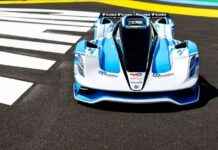With the BWB-300, the fuselage transitions seamlessly into the wings. In China, the futuristic jet took off for a maiden flight, albeit as a model.
They look like a fat pigeon – blended wing body planes. With them, the fuselage is not a tube, but merges into the wings. This is reminiscent of the flying wings like the legendary Horten H IX and today’s stealth bombers.
A model of the BWB-300 has now started in China. This is an airliner that does not use the “blended wing body” design to reduce the radar shadow. Rather, it should increase the gliding effect, which results in lower fuel consumption.
Jet for 300 passengers
Designed to carry about 300 passengers, the BWB-300 is being developed by Northwestern Polytechnical University in China with commercial aircraft manufacturer Comac. The university has been researching the BWB concept for over 20 years, and development of the BWB-300 began in 2017. In a video published on Twitter, you can admire the model’s maiden flight.
Not only China is working on such an aircraft. As early as 2007, Boeing launched the X-48B demonstrator. In 2020, Airbus introduced the Maverick model. They were all miniature models. What is striking about the BWB-300 are the overhead engines, which are also intended to reduce noise pollution. The wide hull leads to special challenges. If the passengers are seated far from the center line, the “roller coaster” movements will increase as the plane turns. In addition, with the wide structure, it must be ensured that the passengers sitting in the middle can also exit the jet quickly in the event of an accident.
Frugal if slow
Because of the reduced consumption and the large interior, these concepts are also suitable for alternative zero-emission drives, such as hydrogen. However, the greatest savings potential arises when the jet flies slower than is usual today.
But then another problem arises: the renaissance of the railway. Today more and more railway concepts for speeds of over 600 km/h are presented and at the same time the high-speed network with speeds of around 350 km/h is being expanded in China. However, the cruising speed of a jet has to be significantly higher than that of a train due to the procedure during take-off and landing in order to remain attractive to passengers.
A few years ago, Mike Sinnett, who is responsible for product development for commercial aircraft at Boeing, warned against overly high expectations of the BWB concept. In his opinion, BWB jets have advantages, especially in the cargo business, but the better aerodynamics pay off above all on long-haul routes, as they are not noticeable during the energy-guzzling take-off. The savings effect is therefore small for medium and small distances. In addition, these jets have a larger wingspan and therefore do not fit in with the facilities at the airports.
What: Aviationweek, Leehamnews
Also read:
“Flying-V” – revolutionary aircraft puts passengers in the wings
The Horten Ho 229 – the most mysterious plane of the Nazis
The Airbus Maveric looks like a stealth bomber, but it’s designed to carry passengers









